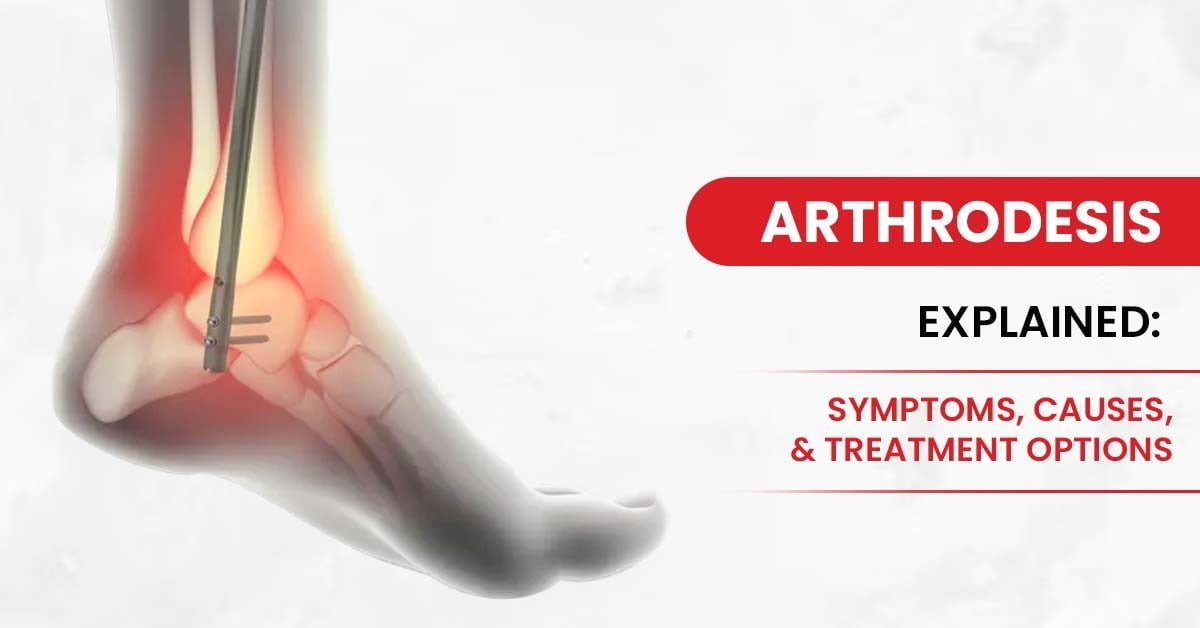


[vc_row][vc_column][vc_column_text]INTRO: Are you suffering from constant, brutal joint pain that has been giving you sleepless nights and restless days? If your answer is yes, there is a possibility that you could also be looking for a viable, permanent solution to it. Arthrodesis, also known as the joint fusion technique, can help you. You are, undoubtedly, now wondering, ‘What is arthrodesis?’. Allow us to explain.
ARTICLE: The world of medicine and surgery is full of miracles designed to suit your health needs and offer you much-needed relief from your pain. Arthrodesis is one of the many stars of the surgical universe that is designed in a way that offers permanent relief to those suffering from crucial joint ailments that need surgery. It is a resort that surgeons take when popping pills no longer seems to work in alleviating a patient’s pain, and surgery seems the only way out.
Arthrodesis is another surgical procedure that is designed to offer relief to those suffering from painful joints. It comes under the faculty of orthopaedics and is performed by a highly skilled orthopaedic surgeon.
DEFINITION OF ARTHRODESIS: As far as the meaning or definition of arthrodesis is concerned, it is a surgical procedure that entails joining two bones at the joint through surgical intervention. Performed manually, arthrodesis requires the expertise of the orthopaedic surgeon to straighten out the damaged joint after removing the cartilage and brace the bone to ensure their collective and simultaneous healing.
In simple terms, arthrodesis is the answer to the prayers of those suffering from medical conditions such as painful joint injuries, fractures, osteoarthritis, and rheumatoid arthritis. To make it even simpler, the arthrodesis meaning is explained in Hindi below.
आर्थ्रोडिसिस की परिभाषा:
आर्थ्रोडिसिस एक सर्जिकल प्रक्रिया है जिसमें सर्जिकल हस्तक्षेप के माध्यम से जोड़ पर दो हड्डियों को जाता है। इसमें मैन्युअल रूप से क्षतिग्रस्त हुई उपास्थ्यस्थि को हटाकर बीमार जोड़ को सीधा करना और हड्डियों को इस तरह जोड़ना कि उन्हें
एक साथ चंगाई प्राप्त हो सके, शामिल होता है। आर्थ्रोडिसिस उन लोगों के लिए एक वरदान है जो जोड़ों की दर्दनाक चोटों, फ्रैक्चर, ऑस्टियोआर्थराइटिस और रह्यूमटॉइड गठिया जैसे रोगों से पीड़ित होते हैं और अपने दर्द से स्थायी छुटकारा चाहते हैं।
आर्थ्रोडिसिस प्रकृया में निम्न शामिल हैं:
Synonymous with joint fusion, arthrodesis indications include conditions that require surgical intervention for healing after all non-surgical treatments have failed to yield the desired results. Arthrodesis indications generally include issues such as joint instability, hyperextension injury of the carpus, valgus foot deformities that cannot be adequately braced, collapsing pes planovalgus deformity, advanced tibialis posterior tendon dysfunction, tarsal coalition, rheumatoid arthritis, degenerative arthritis, and posttraumatic arthritis.
The procedures entailing arthrodesis differ from one joint to another and, hence, are of many types. Types of arthrodesis include total arthrodesis and partial arthrodesis. Both types of arthrodesis aim at providing relief from pain to the patient. Total and partial arthrodesis are often used for treating degenerative wrist ailments.
As mentioned earlier, procedures requiring arthrodesis vary as per the requirements of the ailing joint. Hence, arthrodesis includes surgical processes such as:
Fusion surgeries are also a part of arthrodesis. Surgeries of the hip joint have witnessed an increase in the past few years. This is because of the increasing incidence of ailments pertaining to the hip joint and the resultant need for surgical intervention. Hence, it would be appropriate to talk about hip arthrodesis here. Ironically, hip arthrodesis seems to have
taken a backseat over the years, with surgeons preferring other surgical procedures to treat ailing hip joints. But we are, in no way, implying that hip arthrodesis is irrelevant now. Hip arthrodesis is still as relevant and applicable as per the indications of the disease that it heals.
An alternative to total hip arthroplasty, hip arthrodesis helps restore, brace, and steady the affected hip joint. Hip arthrodesis can come in handy in preserving bone stock, besides delaying the inception of notable pain in adjacent joints for up to two decades or more.
FAQ:
None. Fusion and arthrodesis are two different names for the same procedure.
As discussed earlier, arthrodesis is used when non-surgical procedures have failed to yield the desired results and surgical intervention seems to be the only way to treat an ailing joint, or as per arthrodesis indications.
Arthrodesis may be indicated when non-surgical treatments fail. However, there are several common indications of arthrodesis. Two main arthrodesis indications include joint instability and hyperextension injury of the carpus.
Stiffening of the joint is called ankolysis. Arthrodesis, also known as artificial ankolysis, is a surgical procedure used to treat ailing joints.[/vc_column_text][/vc_column][/vc_row]
September 30, 2024
Recognize the Signs: Understanding Appendicitis Pain Symptoms
September 24, 2024
Unveiling the Truth: I-Pill Side Effects Every Woman Should Know
We use cookies to enhance your experience. By clicking "Accept", you agree to our use of cookies.